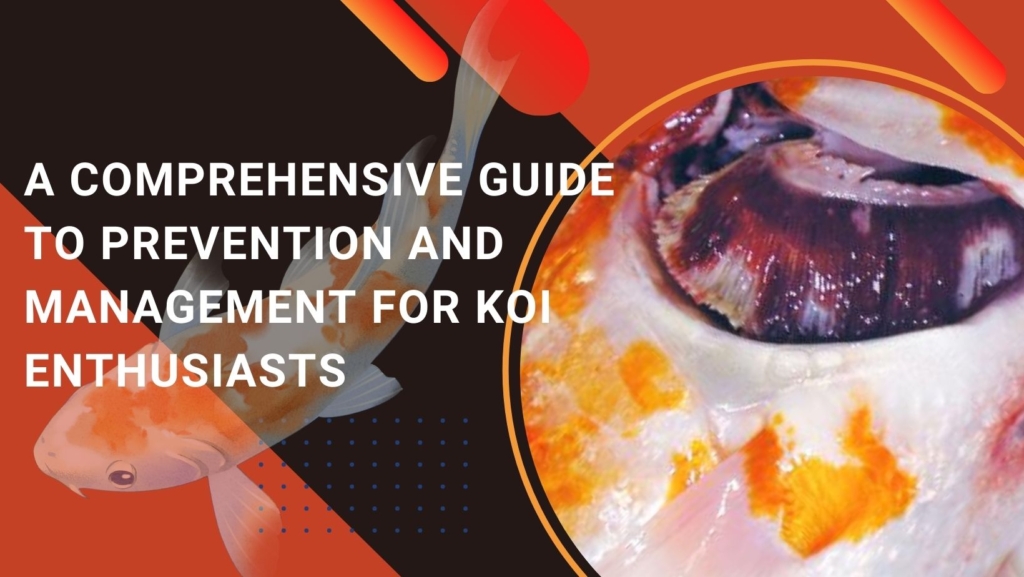
In this article, we’ll share tips and practices we’ve developed for keeping our koi healthy, covering everything from learning about Koi Herpes Virus (KHV) to treatment and prevention. We’re glad to be of assistance, ask questions in the comments.
First rule: Do not jump to the conclusion that your koi have KHV, without testing first. No need to panic, overreact, or make assumptions, until you have a positive test result of KHV.
Yes, the enchanting world of koi-keeping offers joy and tranquility to enthusiasts, but the threat of Koi Herpes Virus (KHV) poses a significant risk to koi. Recognizing symptoms like gill flicking and skin abnormalities is crucial. Treatment involves quarantine and consulting veterinarians.
For prevention of KHV, only buy from trusted koi dealers who have strict biosecurity measures and quarantine protocols. At Kodama Koi Farm we champion disease-free koi through rigorous testing to ensure the well-being of these majestic fish. Together, we can preserve the beauty and legacy of koi-keeping.
Understanding Koi Herpes Virus
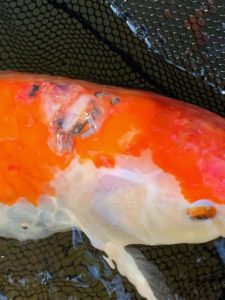 Koi Herpes Virus (KHV) is a highly contagious pathogen affecting common carp and koi, causing significant mortality. It emerged in the late 1990s and spreads globally through direct contact, contaminated water, and environmental factors.
Koi Herpes Virus (KHV) is a highly contagious pathogen affecting common carp and koi, causing significant mortality. It emerged in the late 1990s and spreads globally through direct contact, contaminated water, and environmental factors.
Research focuses on understanding its genetic makeup, transmission patterns, and diagnostic methods like PCR assays. Mitigation strategies include stringent biosecurity measures and collaborative efforts among virologists and aquaculture specialists. Despite progress, challenges persist in controlling KHV outbreaks and protecting carp populations worldwide.
Signs and Symptoms of KHV in Fish
A nuanced understanding of the signs and symptoms associated with KHV is crucial for timely detection and effective management. KHV, or Koi Herpesvirus, primarily affects common carp and koi fish, causing significant economic losses in the aquaculture industry and posing a threat to wild populations. The virus is known for its ability to rapidly spread and cause mass mortalities in infected populations.
Key indicators of Koi KHV
Amidst the tranquil waters and graceful movements of these prized fish, understanding the key indicators of Koi’s Herpes Virus becomes imperative. Koi herpesvirus (KHV) presents a significant threat to koi populations worldwide, causing severe mortality rates and economic losses within the ornamental fish industry. Identifying key indicators of KHV infection is crucial for prompt diagnosis and effective management.
From behavioral changes to physical symptoms, recognizing these indicators can help mitigate the spread of the virus and protect koi populations from devastating outbreaks. Below are the typical indications or signals that a koi might be unwell.
Erratic Swimming Behavior: Infected koi may exhibit erratic swimming patterns, ranging from darting movements to lethargy, reflecting the distress caused by the virus.
Respiratory Distress: KHV often induces respiratory problems, resulting in increased gill movement and gasping at the water’s surface, signaling compromised respiratory functions.
Changes in Skin and Fins: An observant eye is required to detect subtle alterations in skin color, the appearance of ulcers, or fraying fins, which can be indicative of KHV infection.
Unexplained Deaths: Sudden and unexplained deaths within your koi population may serve as a potent warning sign, prompting a thorough investigation into potential KHV presence.
Preventing Koi Herpes Virus
Preventing KHV is a multifaceted endeavor that involves a combination of biosecurity measures, regular testing, and maintaining optimal pond conditions. Do not guess. Just test! I do not intend to scare you; but if you see abnormal Koi deaths, please do not guess; just test. If you decide to test your koi, please start by first contacting your local vet or koi dealer.
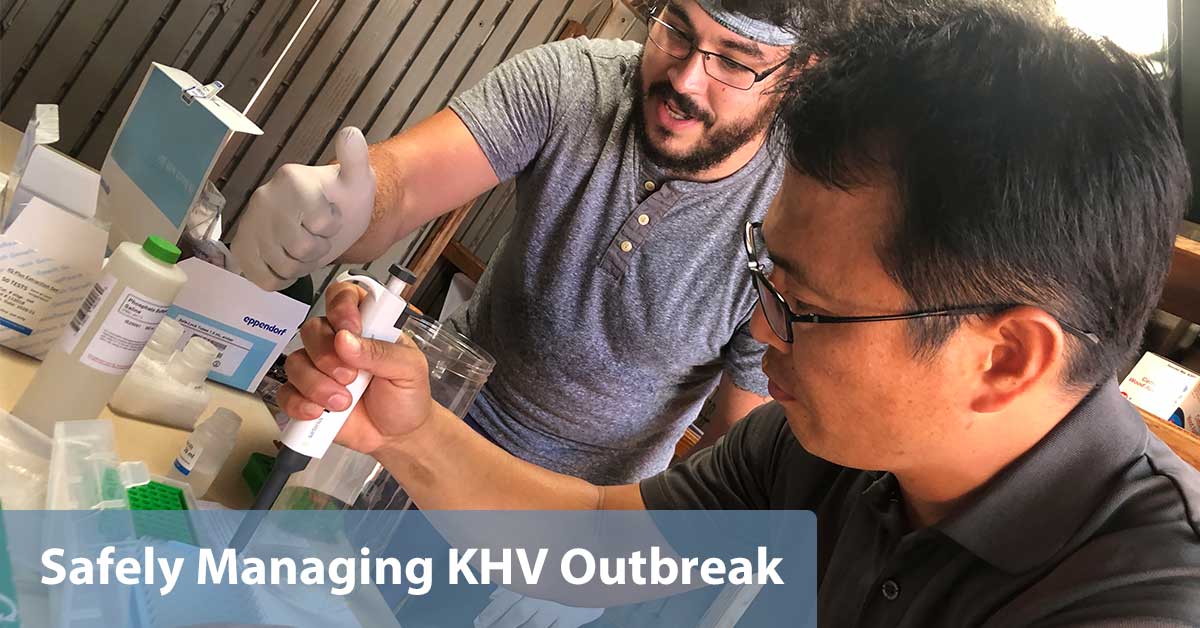
Steps to fortify your KHV defense
1. Quarantine New Fish: Before integrating new koi into your existing population, implement a stringent quarantine period lasting at least four weeks. This precautionary measure helps identify potential carriers of the virus.
2. Regular KHV Testing: Regular KHV testing is not really practical, focus on running the test and quarantine every time new Koi come in. At Kodama Koi Farm, this commitment is taken to the highest degree. It is impossible to test every single koi, so we do testing on each breeder group twice, with 1 month quarantine every time they come from Japan, as our best defensive measures.
3. Water Quality Management: Water quality management is the best way to manage koi health and pristine water conditions alleviate stress on koi, fortify their immune systems and reduce susceptibility to infections. While, water quality management is always important, and with better immune system, koi may have less chances to get KHV, it is not a proven fact. Even in the best water quality, when a virus comes in, it will still make the Koi sick.
4. Limited Pond Access: Minimize the risk of contamination by restricting access to your pond. This applies not only to potential carriers among wild animals and birds but also to human intervention that could inadvertently introduce the virus.
5. Buy From Trusted Sources: It is best to buy only koi from trusted koi dealers where you know they are doing KHV testing and can feel safe buying from them. Purchasing a koi with KHV can unfortunately wipe out your entire pond, so it is best to not try and save money and buy direct from dealers you know are testing.
Maintaining the Health and Well-Being of Beautiful Koi
In the intricate tapestry of koi keeping, the threat of KHV underscores the importance of education, prevention, and a commitment to stringent testing. Through a holistic approach that combines biosecurity measures, vigilant monitoring, and advanced diagnostic techniques, hobbyists can navigate the challenges posed by KHV.
Kodama Koi Farm stands as a beacon of excellence in this regard, ensuring that your journey into the world of koi keeping is not only enchanting but also founded on the principles of health and well-being for these magnificent creatures.
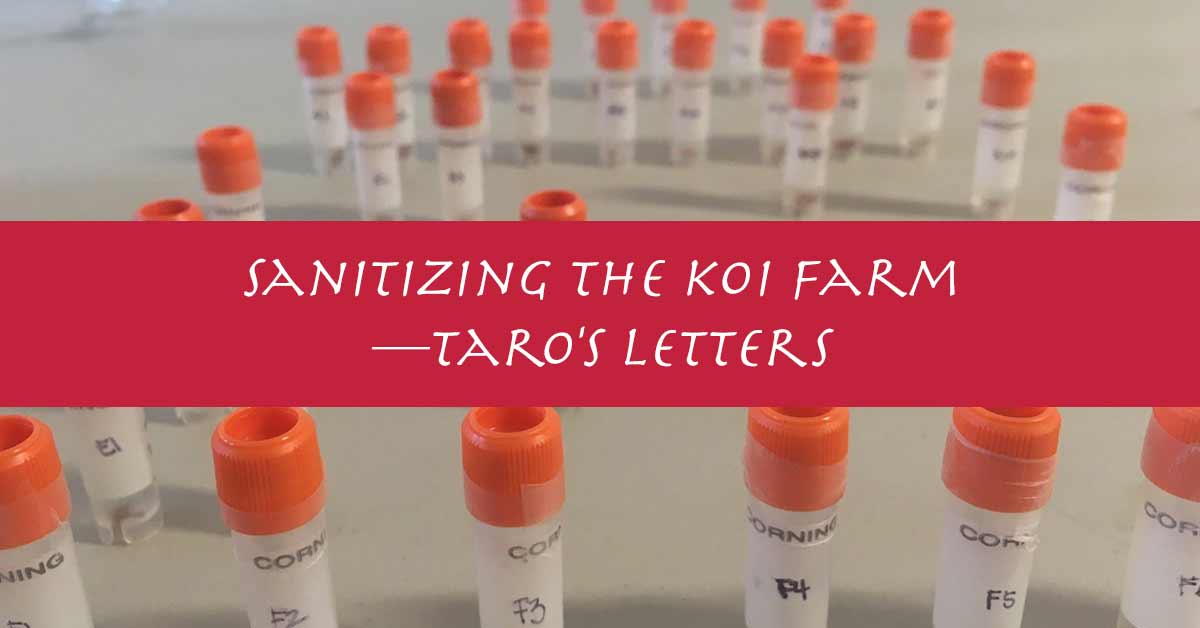
Kodama Koi Farm’s Unwavering Commitment
At the heart of Kodama Koi Farm’s philosophy lies an unwavering commitment to producing healthy, this commitment is palpable in our stringent testing protocols, setting an industry standard for transparency and excellence. Every single koi that leaves our farm undergoes a comprehensive screening process, utilizing state-of-the-art diagnostic techniques such as Polymerase Chain Reaction (PCR) testing. This method ensures highly sensitive and specific detection of the virus, providing our customers with the assurance that the koi they acquire are not only visually stunning but also free from the specter of KHV.
Kodama Koi Farm’s Innovative Approach: Mitigating the Japan KHV Outbreak Through Cutting-Edge Technology and Protocols
Each breeder and dealer, both within and outside Japan, is currently endeavoring to assess the extent of the damage and implement effective measures to contain it. Equipped with innovative technology and protocols, we stand prepared to address any outbreaks effectively. Explore how Kodama Koi Farm is tackling the Japan KHV outbreak using new methodologies and technology on the farm. Starting with additional details on KHV, proceeding to the primary outbreak in Japan during the winter of 2018, then delving into Kodama’s strategy for KHV management, exploring preventative measures, and concluding with inquiries to consider before purchasing Koi. Read and learn more, Visit Safely Managing Japan KHV Outbreak with New Processes and Technology at the Farm, page.

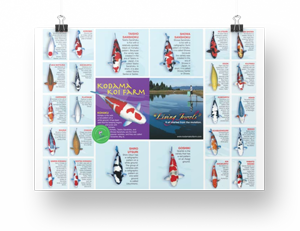

got some koi from a suppler that has the KHV and know i have it in my pond what about my plant will they hold the KHV
Hello, I am sorry for the late reply. As long as the plant is in the water, I can not deny the possibility. I have heard that the virus can live on wet net. So I strongly recommend you should completely disinfect the plans or maybe completely replace them.
Thanks, Taro! This is one of the most valuable guarantees that a koi dealer can give to their customers. People ask me frequently for a safe place to purchase koi. I always refer them to the dealers who have proven to have integrity! As you said in the article, it is not worth saving a few pennies and then lose all the fish you have spent so much of your time cultivating at home! There is ALWAYS another beautiful koi. I have two of your koi in my pond. I wish all the dealers were honest. I would like to be able to share your words of wisdom with some of my callers.
Hi Carolyn, how are you? Thank you so much for your compliments. Coming from you means a lot to me. After all, as a Koi dealer, I would like to make our customers happy with our Japanese Koi. And for that, we are willing to do whatever we can and need to do . Thank you for your support and encouragements.